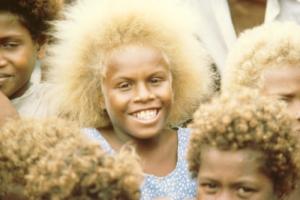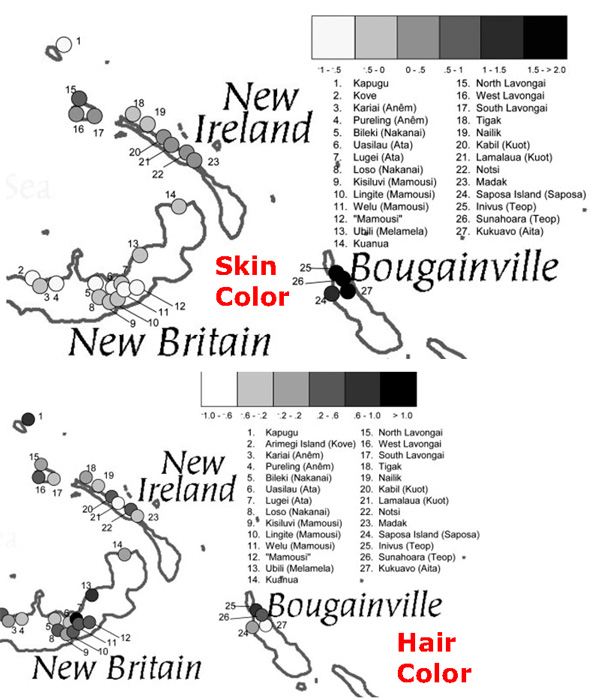|
Friday, October 12, 2007
 The photo to the left is of a girl from Malaita in the Solomon Islands (Photo credit: Jonathan Friedlaender). The Solomons are in the heart of Melanesia, the "black islands." When I was a small child looking through anthropological books I would on occasion stumble upon photographs of very dark-skinned people from Oceania with light hair. Invariably they would not be light-brown Polynesians, but extremely dark Melanesians. You see references to this in C.S. Coon's old books as well. I've been digging for a few years into the nature of the trait of blondism in this part of the world, and I've come upon an interesting paper, Skin and hair pigmentation variation in Island Melanesia. Below the fold there is a map I've cut out of the skin & hair pigmentation. The photo to the left is of a girl from Malaita in the Solomon Islands (Photo credit: Jonathan Friedlaender). The Solomons are in the heart of Melanesia, the "black islands." When I was a small child looking through anthropological books I would on occasion stumble upon photographs of very dark-skinned people from Oceania with light hair. Invariably they would not be light-brown Polynesians, but extremely dark Melanesians. You see references to this in C.S. Coon's old books as well. I've been digging for a few years into the nature of the trait of blondism in this part of the world, and I've come upon an interesting paper, Skin and hair pigmentation variation in Island Melanesia. Below the fold there is a map I've cut out of the skin & hair pigmentation. I'm intrigued by #27 on Bougainville, the Aita. From the text: An interesting hair phenotype that is sometimes seen in Island Melanesia (as well as among Australian Aborigines) is "blondism," in which individuals exhibit the characteristic darkly pigmented skin of the region while also having blond hair. This trait was most commonly observed in children whose hair generally darkened around puberty (Robins, 1991). However, in some cases, blondism persists into adulthood, although the hair appears somewhat darker than what is seen in children. The strikingly light hair of the Aita...is partially due to the high incidence of blondism among this group. So who are the Aita? They're an isolated "Papuan" group. In the context of Melanesia the appellation Papuan is simply a catchall for the host of ancient peoples who were extant in the region before the expansion of Austronesians within the last 5,000 years. Could the blondism be due to European admixture? From the text: The Aita live in an isolated mountainous region of northern Bougainville, and although the Ane'm had recently moved down to the coast they were originally an inland rather than shore-based group. It may be that the resistance of coastal groups to intermarriage with supposedly "darker" populations such as the Aita or Ane'm is really reflective of resistance to intermarriage with inland populations that are generally considered less sophisticated. Whatever the reason, this resistance may help strengthen the genetic differences observed between coastal and inland groups. The median skin color on Bougainville is amongst the darkest in the world, and the Aita are reputed to be among the darker residents of Bougainville. Additionally there is no report of blue eyes amongst these Melanesian peoples, which in Europeans is more common than blonde hair. Two papers, Melanesian mtDNA Complexity and Unexpected NRY Chromosome Variation in Northern Island Melanesia, shed some light on the genetic relationship of the Aita to the other groups in the region. They are it seems an ancient and rather isolated people who are geneticallyhomogeneous in a region characterized by a great deal of between group genetic variation. I am willing to hazard that presence of blondism in Melanesia is a function of the diversity of the region and its relative insulation from demographic sweeps which characterized much of the rest of the world. The Austronesians brought a more advanced culture and acculturated the coastal groups, but the ecology of Melanesia allowed the indigenous peoples, those termed Papuans, to maintain their existence inland. The high frequencies of an anomolous trait such as blondism among the Aita may simply be due to genetic drift through a population bottleneck. But a more curious question is the genetic architecture of blondism among these groups. The peoples of Bougainville are known to be functionally constrained in regards the genes which are implicated in controlling skin color variation. From Signatures of positive selection in genes associated with human skin pigmentation as revealed from analyses of single nucleotide polymorphisms: Our results showed that African populations tended to carry the ancestral alleles of the studied SNPs...and that human populations with dark skin colour tended to cluster together in the MDS and STRUCTURE analyses. The clustering of the Bougainville Islander population reflects the fact that this relationship is not (or at least not solely) caused by geography but also by the underlying pigmentation genes. Bougainville Islanders from Papua New Guinea are known to be one of the most highly pigmented people in the world...In our results they appeared to be closer to Sub-Saharan Africans populations - with whom they share the dark skin colour phenotype - than to the second Papuan New Guinea sample in the dataset, with whom they share their recent population history, as observed in several datasets based on neutral genetic variation from autosomal, Y-chromosomal and mtDNA analyses.... So how are they blonde? The genes which seem to control variation in human skin color seem to have some effect on hair color. Blondism in Europeans is simply due to low levels of eumelanin (brown) and pheomelanin (reddish), and the darkening of skin naturally has a tendency to upregulate the production of melanin globally so as to darken hair. How can the peoples of Bougainville retain dark skin while selectively downregulating the production to their hair? Well, we know that the region around OCA2 is implicated in a quasi-Mendelian disproportionate reduction in the pigment level in the iris. One assumes that something similar is theoretically feasible for hair.... Labels: human biodiversity, Pigmentation |



